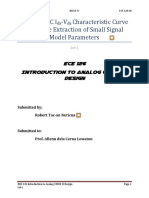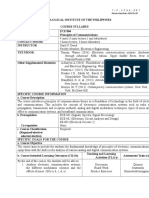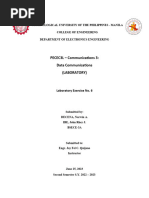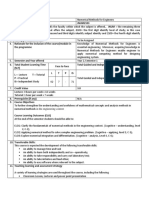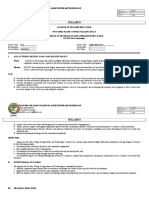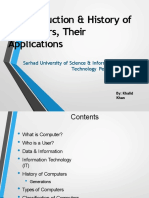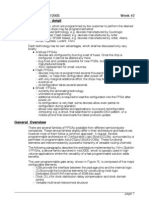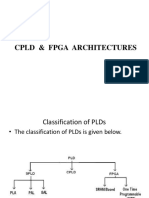Microprocessor System Syllabus OBE
Uploaded by
GilCuajuncoMicroprocessor System Syllabus OBE
Uploaded by
GilCuajuncoPOLYTECHNIC UNIVERSITY OF THE PHILIPPINES
Maragondon, Cavite
COURSE SYLLABUS
COLLEGE: ENGINEERING
DEPARTMENT: ELECTRICAL ENGINEERING
COURSE TITLE: MICROPROCESSOR SYSTEM
COURSE CODE: ELEN 3393
NO. OF UNITS: __3 LECTURE HOURS: __2__ LABORATORY HOURS: ___3___
PRE-REQUISITES, CO-REQUISITES: _______________________
CLASS SCHEDULE: ____________________________
INSTRUCTOR: VIRGILIO R. CUAJUNCO, JR.
PART I. COURSE DESCRIPTION
RATIONALE:
The Microprocessors course is designed to teach you the fundamentals of the microprocessor unit (MPU), or as it is also
known, the central processor unit (CPU). This is the decision maker, or brain, of the computer. Like the brain in your body, the MPU
needs support from many peripheral devices to maintain the system. Because of that interrelationship, a course on microprocessors
is not complete without a through discussion of how the MPU interfaces to its support devices and the outside world. To that end,
we will show you how the MPU is structured, how you communicate with the MPU (its language), and how the MPU communicates
with you and the system under its control.
OBJECTIVES:
The microprocessor revolution, which placed a central processing unit (CPU) on a single integrated circuit "chip," has turned
the computer into a handful of chips and has handed these chips over to the electrical engineer—that is, an electrical engineer can
now take a microprocessor and design it into a system whose complexity may vary from the trivial to the sophisticated. How a
microprocessor is transformed into a system capable of performing its intended task will be learned. It concentrates on the interface
between the microprocessor and the other components of a microprocessor system.
OUTCOMES:
When you have completed this course, you will be able to program a representative microprocessor and interface a
representative microprocessor with the "outside world." To describe the internal register structure of the 6800 and 6808
microprocessors. Develop a program flowchart to define a problem and Input and output data through a Peripheral Interface
Adapter. To consider societal impact and implications of technology. A knowledge of area should allow each student to evaluate his
own potential in the field.
PART II. LEARNING OUTCOMES
PUP Graduate Attributes PROGRAM OUTCOME
Competitive engineers who will Equipped with appropriate knowledge and technical skills, imbued with desirable work
serve as catalysts for sustainable attitude and moral values through enhanced teaching/learning process by using multi-media
growth and development in facilities on top of traditional methods.
national and international levels.
Describe the most common number systems and codes used by computers.
Introduce the basic elements of a microprocessor
Understands how a microprocessor manipulates a number system and introduce to
programming a computer.
Describes interfacing fundamentals; including 3-state logic, all of the interface pins on the
6800 and 6808 microprocessor, and instruction timing. It also describes memory and display
interfacing.
Interface with switches and the Peripheral Interface Adapter.
Introduces the basic building blocks of a microprocessor system and provides a framework
within which a real system can be discussed.
Develop all of his/her personal qualities and abilities.
POLYTECHNIC UNIVERSITY OF THE PHILIPPINES
Maragondon, Cavite
PART III. LEARNING PLAN
LEARNING OUTCOME TOPIC LEARNING ACTIVITIES LEARNING ASSESSMENT
Discuss and explain the course syllabus, Course Description and Discussion Active participation and
policies, and grading system Outline, Class Policies, Lecture compliance of the students
Grading System to the university and
course rules and
regulations
Given any decimal number, you will be Number Systems and Lecture Class participation,
able to convert it into its binary, octal, Codes Discussion recitation, Quiz
hexadecimal, and BCD equivalent. Computer Hands-on
Given any binary number, you will be
able to convert it into its decimal, octal,
hexadecimal, and BCD equivalent.
Given any octal number, you will be able
to convert it into its decimal and binary
equivalent.
Given any hexadecimal number, you will
be able to convert it into its decimal and
binary equivalent.
Given any BCD code, you will be able to
convert it into its decimal and binary
equivalent.
Given a list of popular digital codes, you
will be able to read and identify them
including pure binary, natural8421 BCD,
Gray, ASCII, and BAUDOT.
Able to convert a letter or number into
its ASCII binary code, and
Convert an ASCII binary code into its
letter or number equivalent.
Define the different terms and acronyms Microcomputer Basics Lecture Class participation,
on a microcomputer systems Discussion Assignment,
terminology Computer Hands-on Presentation,
Quiz
Explain the purpose of the circuits in a
typical microprocessor
Using a simplified block diagram of a
hypothetical microprocessor, trace the
data flow that takes place between the
various circuits during the execution of a
simple program.
Describe the .difference between
inherent, immediate, and direct
addressing.
Write simple, straight-line programs that
can be executed by the ET -3400
Microprocessor Trainer.
POLYTECHNIC UNIVERSITY OF THE PHILIPPINES
Maragondon, Cavite
LEARNING OUTCOME TOPIC LEARNING ACTIVITIES LEARNING ASSESSMENT
Add two binary numbers. Computer Arithmetic Lecture Class participation,
Discussion Assignment,
Subtract one binary number from Computer Hands-on Presentation,
another. Quiz
Multiply one binary number by another.
Divide one binary number by another.
Derive the one's complement of a binary
number.
Derive the two's complement of a binary
number.
Add binary numbers using two's
complement arithmetic.
Manipulate binary numbers using the
AND operation.
Manipulate binary numbers using the OR
operation.
Manipulate binary numbers using the
exclusive OR operation.
Logically invert binary numbers.
Draw the symbols used in flow charting Introduction to Lecture Class participation,
and explain the purpose of each. Programming Discussion Assignment,
Computer Hands-on Presentation,
Develop flow charts that illustrate step- Quiz
by-step procedures for solving simple
problems.
Explain the purpose of conditional and
unconditional branching.
Using the block diagram of the
hypothetical microprocessor, trace the
data flow during the execution of a
branch instruction.
Compute the proper relative address for
branching forward or backward from one
point to another in a program.
Explain the purpose of the carry,
negative, zero, and overflow flags. Giv0e
an example of a situation that can cause
each to be set and another example that
will cause each to clear. List eight
instructions that test one of these flags.
Write programs that can: multiply by
repeated addition; divide by repeated
subtraction; convert binary to BCD;
convert BCD to binary; add multiple-
precision numbers; subtract multiple-
precision numbers; add BCD numbers.
POLYTECHNIC UNIVERSITY OF THE PHILIPPINES
Maragondon, Cavite
LEARNING OUTCOME TOPIC LEARNING ACTIVITIES LEARNING ASSESSMENT
Draw a programming model of the 6800 The 6800 Microprocessor Lecture Class participation,
MPU. Discussion Assignment,
Computer Hands-on Presentation,
Explain the purpose of each block in a Quiz
simplified block diagram of the 6800
MPU.
Explain the operation of all the
instructions discussed in this unit.
Write simple programs that use indexed
and extended addressing.
Determine the opcode, number of MPU
cycles, number of bytes, and effects on
the condition code flags of every
instruction discussed in this unit.
Explain the difference between a cascade
stack and a memory stack.
Write simple programs that can store
data in- and retrieve data from - the
stack.
Write programs that use the stack and
indexing to move a list from one place in
memory to another.
Explain the operations performed by
each of the following instructions: PULA,
PULB, PSHA, PSHB, DES, INS, LOS, STS,
TXS, and TSX.
Define stack, subroutine, nested
subroutine, interrupt, interrupt vector,
and interrupt masking.
Write programs that use subroutines and
nested subroutines.
Explain the operations performed by
each of the following instructions: JMP,
JSR, BSR, and RTS.
Describe how the 6800 MPU performs
input and output operations.
Draw flowcharts depicting the sequence
of events that occur during reset, non-
maskable interrupt, interrupt request,
software interrupt, return from
interrupt, and wait for interrupt.
Explain the operation performed by each
of the following instructions:
WAI, SWI, RTI, SEI, and CLI.
POLYTECHNIC UNIVERSITY OF THE PHILIPPINES
Maragondon, Cavite
PART IV. REFERENCES
MICROPROCESSORS BOOK 1/BOOK 2 by Heathkit Educational System
MICROPROCESSOR SYSTEMS DESIGN, 3rd Edition, by ALAN CLEMENTS, PWS PUBLISHING COMPANY
PART V. GRADING SYSTEM
The final grade will be the average of the 1st and 2nd grading period
Quizzes 30%
Recitations/Assignments/SW 10%
Attendance 10%
Experiments 20%
Major Exam (Midterm/Final) 30%
Total 100%
PART VI. CLASS POLICIES
1This is a course about Information Technology and several assignments/activities require use of a PC. Students can use
either their own PC or the facilities of the School Computer Laboratory.
A student will be considered absent or tardy, if not present during roll call.
A student shall be considered late or tardy, if he arrived in class during the first half fraction of the scheduled class time.
Three incidences of tardiness shall be considered as one absence from class
Absences due to illness may be excused if the student submits a medical certificate and/or excused letter signed by the
parent/guardian.
Academic dishonesty of any form will not be tolerated.
PART VII. COURSE CALENDAR
SESSION DATE OF CLASSES TOPIC
1 November 2016 Course Description and Outline, Class Policies, Grading System
2 November 2016 NUMBER SYSTEMS AND CODES
Decimal Number System
Binary Number System
Octal Number System
Hexadecimal Number System
Binary Codes
Positive Powers of 2
Negative Powers of 2
Positive Powers of 8
Positive Powers of 16
Negative Powers of 16
3 November 2016 Experiment 1
4 November 2016 Experiment 2
5 December 2016 MICROCOMPUTER BASICS
Terms and Conventions
An Elementary Microcomputer
Executing a Program
Addressing Modes
6 December 2016 Experiment 3
7 December 2016 COMPUTER ARITHMETIC
Binary Arithmetic
Two's Complement Arithmetic
Boolean Operations
8 January 2017 Experiment 4
9 January 2017 MIDTERM EXAM
POLYTECHNIC UNIVERSITY OF THE PHILIPPINES
Maragondon, Cavite
10 January 2017 INTRODUCTION TO PROGRAMMING
Branching
Conditional Branching
Microcomputer Programming
Algorithms
Additional Instructions
11 February 2017 Experiment 5
12 February 2017 Experiment 6
13 February 2017 THE 6800 MICROPROCESSOR
Architecture of the 6800 MPU
Instruction Set of the 6800 MPU
New Addressing Modes
14 February 2017 Experiment 7
Experiment 8
15 March 2017 Stack Operations
Experiment 9
16 March 2017 Subroutines
Experiment 10
17 March 2017 Input - Output Operations
Interrupts
18 March 2017 FINAL EXAM
Prepared by:
PROF. VIRGILIO R. CUAJUNCO, JR.
Faculty Member
Approved by:
ENGR. JIMMY PANGANIBAN
Area Coordinator BSEE
DR. AGNES Y. GONZAGA
Head, Academic Programs
PROF. DENISE A. ABRIL
Director
POLYTECHNIC UNIVERSITY OF THE PHILIPPINES
Maragondon, Cavite
Experiments
1 - Binary/Decimal Training Program . . . . . . . . . . . 3
2 - Hexadecimal/Decimal Training Program . . . . . 13
3 - Straight Line Programs . . . . . . . . . . . . . . . . . . . 23
4 - Arithmetic and Logic Instructions . . . . . . . . . . 41
5 - Program Branches . . . . . . . . . . . . . . . . . . . . . . . 53
6 - Additional Instructions . . . . . . . . . . . . . . . . . . . 89
7 - New Addressing Modes . . . . . . . . . . . . . . . . . 111
8 - Arithmetic Operations . . . . . . . . . . . . . . . . . . . 121
9 - Stack Operations ....................... 133
10 - Subroutines ............................ 141
EXAMINATIONS
Unit 1 Examination - Number Systems and Codes ......... 165
Unit 2 Examination - Microcomputer Basics .............. 169
Unit 3 Examination - Computer Arithmetic . . . . . . . . . . . . . . . 173
Unit 4 Examination - Introduction to Programming . . . . . . . . 175
Unit 5 Examination - The 6800 Microprocessor - Part 1 177
Unit 6 Examination - The 6800 Microprocessor - Part 2 . . . 185
APPENDIX A-DEFINITION OF THE EXECUTABLE INSTRUCTIONS
INDEX
PROGRAMMING CARD- 6800/6808 INSTRUCTION SET
(BOOK 1 TEAR-OUT)
You might also like
- Communicating, Controlling, and LeadingNo ratings yetCommunicating, Controlling, and Leading18 pages
- MOSFET DC Ids-Vds Characteristic Curve and Spice Extraction of Small Signal Model Parameters100% (2)MOSFET DC Ids-Vds Characteristic Curve and Spice Extraction of Small Signal Model Parameters22 pages
- Packet Tracer - Sensors and The PT Microcontroller100% (1)Packet Tracer - Sensors and The PT Microcontroller3 pages
- GI MicroElectronics Data Catalog 1978 Index PDFNo ratings yetGI MicroElectronics Data Catalog 1978 Index PDF22 pages
- Introductory Concepts of Circuit Topology and DC ExcitationsNo ratings yetIntroductory Concepts of Circuit Topology and DC Excitations34 pages
- CMO 24 s2008 Annex III Course Specification For The BSECENo ratings yetCMO 24 s2008 Annex III Course Specification For The BSECE37 pages
- Feedback and Control Systems Course Syllabus 2012-2013100% (1)Feedback and Control Systems Course Syllabus 2012-20135 pages
- Industrial Electronics Lecture Notes 01 Orientation and Introduction PDFNo ratings yetIndustrial Electronics Lecture Notes 01 Orientation and Introduction PDF7 pages
- Logic Families in Digital Electronics - TTL, Cmos, and EclNo ratings yetLogic Families in Digital Electronics - TTL, Cmos, and Ecl35 pages
- ECE103 Logic Design and Switching Theory Introduction and Chapter 1100% (3)ECE103 Logic Design and Switching Theory Introduction and Chapter 1115 pages
- ECE 027 - Module 1 - Introduction About Semiconductor DiodesNo ratings yetECE 027 - Module 1 - Introduction About Semiconductor Diodes54 pages
- DECENA - IBE - Laboratory Exercise No 6No ratings yetDECENA - IBE - Laboratory Exercise No 616 pages
- Single Phase Full Wave Voltage Multiplier PDF0% (1)Single Phase Full Wave Voltage Multiplier PDF3 pages
- ECET512L - Transmission Media and Antenna SystemsNo ratings yetECET512L - Transmission Media and Antenna Systems4 pages
- Logic Circuits and Switching Theory: By: John Neil F. RomasantaNo ratings yetLogic Circuits and Switching Theory: By: John Neil F. Romasanta59 pages
- Module 11 Fetch Decode Execute Cycle V1No ratings yetModule 11 Fetch Decode Execute Cycle V116 pages
- List of Laws For ECE Electronics Engineers in The PhilippinesNo ratings yetList of Laws For ECE Electronics Engineers in The Philippines1 page
- ECE 424FL - Feedback and Control Systems Laboratory - RevisedNo ratings yetECE 424FL - Feedback and Control Systems Laboratory - Revised7 pages
- Data Communication and Computer Network SyllabusNo ratings yetData Communication and Computer Network Syllabus8 pages
- MATH 21EE Advanced Engineering Mathematics For EENo ratings yetMATH 21EE Advanced Engineering Mathematics For EE6 pages
- Lab 5 - Combinational Logic Modules - Adders and SubtractorsNo ratings yetLab 5 - Combinational Logic Modules - Adders and Subtractors13 pages
- Advanced Engineering Mathematics SyllabusNo ratings yetAdvanced Engineering Mathematics Syllabus7 pages
- Logic Circuits and Design Course Outline 311No ratings yetLogic Circuits and Design Course Outline 3116 pages
- IM ECEN 30114 ECE Laws Contracts Ethics Safety and StandardsNo ratings yetIM ECEN 30114 ECE Laws Contracts Ethics Safety and Standards167 pages
- Signals Spectra Processing PowerPoint PresentationNo ratings yetSignals Spectra Processing PowerPoint Presentation8 pages
- Lab 04 Laplace and Inverse Laplace Transforms On MatlabNo ratings yetLab 04 Laplace and Inverse Laplace Transforms On Matlab17 pages
- Syllabus - Math 23EE - Engineering Mathematics For EENo ratings yetSyllabus - Math 23EE - Engineering Mathematics For EE7 pages
- Digital Electronics with Arduino: Learn How To Work With Digital Electronics And MicroControllersFrom EverandDigital Electronics with Arduino: Learn How To Work With Digital Electronics And MicroControllers5/5 (1)
- All chapters of Solution Manual for Computer Organization and Architecture, 11th Edition, William Stallings are available for quick PDF download100% (4)All chapters of Solution Manual for Computer Organization and Architecture, 11th Edition, William Stallings are available for quick PDF download46 pages
- Advanced Micro Devices (AMD) : Gabay, Stephen Elly F. Coeprof 17No ratings yetAdvanced Micro Devices (AMD) : Gabay, Stephen Elly F. Coeprof 175 pages
- Introduction & History of Computers, Their Applications: Sarhad University of Science & Information Technology PeshawarNo ratings yetIntroduction & History of Computers, Their Applications: Sarhad University of Science & Information Technology Peshawar26 pages
- SPRING 2015 CDA 3101 Homework 3: Date-Assigned: Mar 27th, 2015 Due Dates: 11:55pm, April 7th, 2015No ratings yetSPRING 2015 CDA 3101 Homework 3: Date-Assigned: Mar 27th, 2015 Due Dates: 11:55pm, April 7th, 20155 pages
- Design Process in Embedded System Session 03No ratings yetDesign Process in Embedded System Session 0312 pages
- Microprocessor and Microcontroller (324EE) Sheet 1: Dr. Salman Arafath MohammedNo ratings yetMicroprocessor and Microcontroller (324EE) Sheet 1: Dr. Salman Arafath Mohammed13 pages
- Lecture 1 Intro To Digital CommunicationNo ratings yetLecture 1 Intro To Digital Communication24 pages
- Selective Branch Prediction Schemes Based On FPGA MIPS Processor For Educational PurposesNo ratings yetSelective Branch Prediction Schemes Based On FPGA MIPS Processor For Educational Purposes9 pages
- Unit 6 - Week 4 - Biasing A MOS Transistor at A Fixed Drain Current CS Amplifier Using Drain Feedback Bias and Current Mirror BiasNo ratings yetUnit 6 - Week 4 - Biasing A MOS Transistor at A Fixed Drain Current CS Amplifier Using Drain Feedback Bias and Current Mirror Bias6 pages
- VLSI Physical Design - Physical Design (Power Planning) Interview Question Part 5100% (1)VLSI Physical Design - Physical Design (Power Planning) Interview Question Part 52 pages
- An Intro To ArduinoFrom Zero To Hero in An Hour100% (1)An Intro To ArduinoFrom Zero To Hero in An Hour32 pages
- MOSFET DC Ids-Vds Characteristic Curve and Spice Extraction of Small Signal Model ParametersMOSFET DC Ids-Vds Characteristic Curve and Spice Extraction of Small Signal Model Parameters
- Packet Tracer - Sensors and The PT MicrocontrollerPacket Tracer - Sensors and The PT Microcontroller
- Introductory Concepts of Circuit Topology and DC ExcitationsIntroductory Concepts of Circuit Topology and DC Excitations
- CMO 24 s2008 Annex III Course Specification For The BSECECMO 24 s2008 Annex III Course Specification For The BSECE
- Feedback and Control Systems Course Syllabus 2012-2013Feedback and Control Systems Course Syllabus 2012-2013
- Industrial Electronics Lecture Notes 01 Orientation and Introduction PDFIndustrial Electronics Lecture Notes 01 Orientation and Introduction PDF
- Logic Families in Digital Electronics - TTL, Cmos, and EclLogic Families in Digital Electronics - TTL, Cmos, and Ecl
- ECE103 Logic Design and Switching Theory Introduction and Chapter 1ECE103 Logic Design and Switching Theory Introduction and Chapter 1
- ECE 027 - Module 1 - Introduction About Semiconductor DiodesECE 027 - Module 1 - Introduction About Semiconductor Diodes
- Logic Circuits and Switching Theory: By: John Neil F. RomasantaLogic Circuits and Switching Theory: By: John Neil F. Romasanta
- List of Laws For ECE Electronics Engineers in The PhilippinesList of Laws For ECE Electronics Engineers in The Philippines
- ECE 424FL - Feedback and Control Systems Laboratory - RevisedECE 424FL - Feedback and Control Systems Laboratory - Revised
- Lab 5 - Combinational Logic Modules - Adders and SubtractorsLab 5 - Combinational Logic Modules - Adders and Subtractors
- IM ECEN 30114 ECE Laws Contracts Ethics Safety and StandardsIM ECEN 30114 ECE Laws Contracts Ethics Safety and Standards
- Signals Spectra Processing PowerPoint PresentationSignals Spectra Processing PowerPoint Presentation
- Lab 04 Laplace and Inverse Laplace Transforms On MatlabLab 04 Laplace and Inverse Laplace Transforms On Matlab
- Syllabus - Math 23EE - Engineering Mathematics For EESyllabus - Math 23EE - Engineering Mathematics For EE
- Digital Electronics with Arduino: Learn How To Work With Digital Electronics And MicroControllersFrom EverandDigital Electronics with Arduino: Learn How To Work With Digital Electronics And MicroControllers
- Mastering C: Advanced Techniques and Best PracticesFrom EverandMastering C: Advanced Techniques and Best Practices
- Mastering Data Structures and Algorithms in Python & JavaFrom EverandMastering Data Structures and Algorithms in Python & Java
- All chapters of Solution Manual for Computer Organization and Architecture, 11th Edition, William Stallings are available for quick PDF downloadAll chapters of Solution Manual for Computer Organization and Architecture, 11th Edition, William Stallings are available for quick PDF download
- Advanced Micro Devices (AMD) : Gabay, Stephen Elly F. Coeprof 17Advanced Micro Devices (AMD) : Gabay, Stephen Elly F. Coeprof 17
- Introduction & History of Computers, Their Applications: Sarhad University of Science & Information Technology PeshawarIntroduction & History of Computers, Their Applications: Sarhad University of Science & Information Technology Peshawar
- SPRING 2015 CDA 3101 Homework 3: Date-Assigned: Mar 27th, 2015 Due Dates: 11:55pm, April 7th, 2015SPRING 2015 CDA 3101 Homework 3: Date-Assigned: Mar 27th, 2015 Due Dates: 11:55pm, April 7th, 2015
- Microprocessor and Microcontroller (324EE) Sheet 1: Dr. Salman Arafath MohammedMicroprocessor and Microcontroller (324EE) Sheet 1: Dr. Salman Arafath Mohammed
- Selective Branch Prediction Schemes Based On FPGA MIPS Processor For Educational PurposesSelective Branch Prediction Schemes Based On FPGA MIPS Processor For Educational Purposes
- Unit 6 - Week 4 - Biasing A MOS Transistor at A Fixed Drain Current CS Amplifier Using Drain Feedback Bias and Current Mirror BiasUnit 6 - Week 4 - Biasing A MOS Transistor at A Fixed Drain Current CS Amplifier Using Drain Feedback Bias and Current Mirror Bias
- VLSI Physical Design - Physical Design (Power Planning) Interview Question Part 5VLSI Physical Design - Physical Design (Power Planning) Interview Question Part 5





